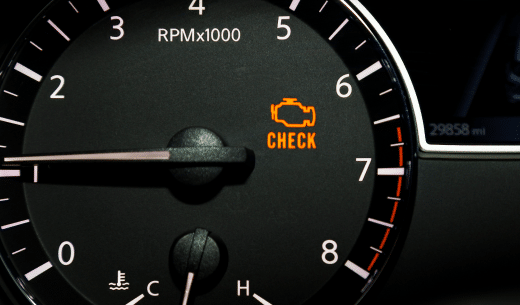Trust and Honesty: Experience the Difference
Check Engine Light
When the check engine light comes on, it often sends a shiver down the spine – many people automatically assume they’re in for a costly repair. However, that’s not always the case; the severity and cost of the issue depend on the specific problem and the time it takes to diagnose it. You might be wondering, “Doesn’t the computer tell you what’s wrong?” Well, yes and no. The code stored by the computer serves, in most instances, as a clue rather than a precise diagnosis. At CarDi Automotive, we provide auto repair services in Winter Haven, FL, including comprehensive diagnosis and resolution of check engine light issues.

What is the
Check Engine Light?
The check engine light is part of your vehicle’s On-Board Diagnostic System (OBD-II). This warning light serves to alert you to problems related to the engine, transmission, or emissions control systems. The issue could range from something as trivial as a loose gas cap to more serious concerns like a malfunctioning Electronic Control Module.
Diagnosing a Check Engine Light
Reading the diagnostic codes is only the initial step in addressing a check engine light. Most codes provide hints rather than definitive answers. For instance, an oxygen sensor code could indicate a range of issues: the sensor itself might be faulty, the wiring could be damaged, the O2 heater might be malfunctioning, or even the air-to-fuel mixture could be imbalanced.
The subsequent steps depend both on the specific code and the vehicle in question. Not all vehicles have distinct codes to indicate sensor failures versus out-of-range readings. Our certified auto technicians rely on a host of specialized diagnostic tools and equipment to pinpoint the exact problem.

Types of Problems the
Check Engine Light Shows
When onboard diagnostics first came out, it only showed problems related to emissions. Now it shows several types of problems, including:
- Emission Control Problems: This is the most common reason a check engine light illuminates. These usually show up as out-of-range readings for various sensors.
- Sensor Malfunctions: If a sensor or the wiring to the sensor is bad, the engine light will show a code.
- Ignition System Issues: These include issues with spark plugs, coils and other ignition parts. They lead to out-of-range readings by sensors.
- Fuel System Issues: The fuel injectors, fuel pressure and fuel mixture can all cause sensors to have out-of-range readings.
- Exhaust Gas Recirculation System: The EGR is technically part of the exhaust system. The EGR valve recirculated exhaust gasses back through the engine.
- Catalytic Converter Problems: If the catalytic converter fails, it could cause the check engine light to illuminate.
- Mechanical Issues: A failing transmission component, serious engine or transmission problems, or even a misfiring cylinder could cause the check engine light to illuminate.
The code only shows us where to look for the issue. Most of the issues require additional diagnosis. If the electronic control module (ECM) is bad, the check engine light illuminates, but since the ECM can’t diagnose itself, it may throw erroneous codes.
In some cases, we can remove it and tell by looking at it and smelling it. It will have a rotten egg odor if it’s bad – sometimes. Other times, we may have to back probe each wire going into the ECM to figure out whether the issue is the ECM itself or in the wiring to several sensors.

